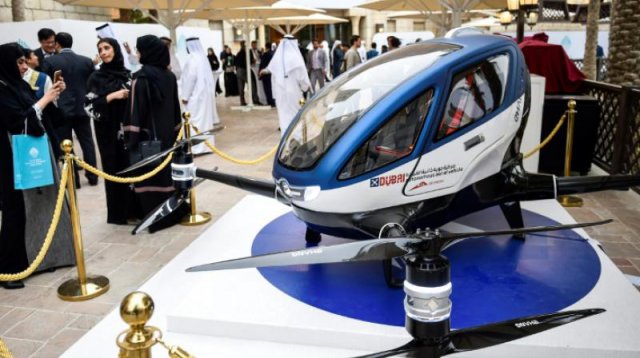Chinese small unmanned-aircraft manufacturer Ehang plans the launch next year of a commercial version of its autonomous single-passenger vertical-takeoff-and-landing air vehicle that flies without a pilot, under the control of a plug-and-play iPad.
That vehicle will likely be larger and heavier as the current Ehang 184 is weight-limited to a single passenger of 220 lb. Whether it will have a second seat remains to be seen, Ehang co-founder Derrick Xiong told Aviation Week at EAA AirVenture.
The eight-rotor vehicle is on display here in its first presentation to an aviation audience since its unveiling in January 2016 at the Consumer Electronics Show in Las Vegas.
“We want to expose it to the most hardcore aviation people in the world, and they’re here at Oshkosh, before we finalize our commercial version,” he said.
The vehicle currently occupies an awkward spot as being too heavy to fit the Federal Aviation Administration’s 55-lb weight limit for commercial drones, yet it cannot qualify as an experimental aircraft because it is autonomous and has no pilot. And one that carries a person, no less, for which there are no FAA regulations. “We are in discussions with the FAA,” says Xiong.
He disclosed that a piloted version could be developed if there is sufficient demand. In that case the pilot would need a pilot license, whereas a sole passenger flying by iPad would not.
More than 20 Ehang 184s have flown in the development program since the company was founded just over three years ago. While Xiong would not admit to any of them crashing,
“I won’t say we never failed,” he notes. “That’s what a test program is for.”
Passenger-carrying flights have been conducted, including with the vice-mayor of Guangzhou, China, and senior officials in Dubai, where “a couple” of the craft have been under test in desert conditions since January.
Dubai is slated to carry out full personal-taxi trials with the Ehang as soon as the craft receives permits from authorities there. Xiong could not say when that might be, except that it has added safety features including one- or two-propeller out and other redundancies. “The authorities there are confident with our technology,” he says.
Ehang also has the technology to fly fleets of autonomous vehicles safely in crowded areas thanks to its founder developing a command and control center for the Beijing 2008 Olympics, Xiong notes. That center, which managed, monitored and controlled the city’s helicopters, police, medical and emergency services, and is still in operation there, has been adapted to control future fleets of Ehang quad-rotors and can be supplied in different locations.
The company has adequate funds to continue development of the air traffic and aerial systems for Ehang after raising $52 million with series A and B issues, and another round of financing from an undisclosed investor, Xiong says.
Next year Ehang plans to launch a Pioneer Program for those who want to buy a personal autonomous flying vehicle, which will be priced around $200,000 for the autopiloted version.
“We’re looking for those who want to be first, either as backers or pioneers,” Xiong says. Perhaps there are a few of them in the crowds at AirVenture, he adds.
Source: Aviation Week


It is a Light Sport Aircraft with a wireless control system! It does not meet the definition of a “drone” or Unmanned Aerial Vehicle because it requires an IPad controller operated by the occupant to fly!
Apple seems to have range issues with its IPad, hardly making the E-184 a “drone”!
https://discussions.apple.com/thread/4616480?tstart=0